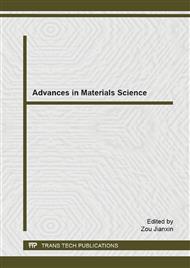p.783
p.788
p.792
p.797
p.802
p.807
p.814
p.819
p.824
Simulation of Drying Hevea brasiliensis Wood
Abstract:
The Simpson model proposes that the rate of wood drying is directly proportional to average moisture content. In this work was done the fitting and the reproduction of drying curve for Hevea brasiliensis wood through of Simpson model and the chi-square statistical method. The curves were obtained by drying 108 specimens Hevea brasiliensis wood with size 10 mm x 20 mm x 100 mm that were drying in a laboratory kiln. The drying control was performed through gradual temperature increase in order to minimize the errors arising due the drastic loss of moisture by wood. The gravimetric method was used to evaluate the drying process, the specimens have theirs mass measured every 6 hours until the timber reached the theoretical anhydrous state. The drying curve of rubber wood obtained here can be used to estimate the drying time of this species for different kiln temperature settings.
Info:
Periodical:
Pages:
802-806
Citation:
Online since:
February 2015
Keywords:
Price:
Сopyright:
© 2015 Trans Tech Publications Ltd. All Rights Reserved
Share:
Citation:


